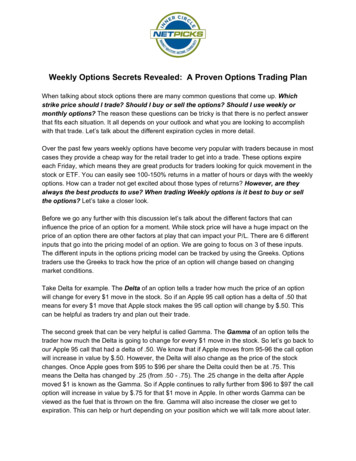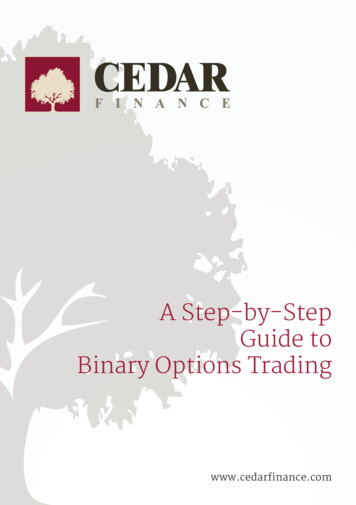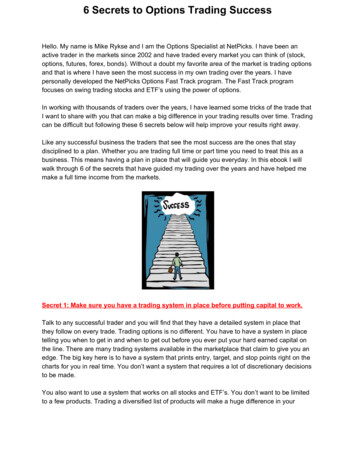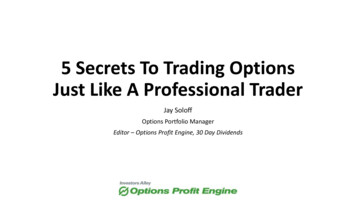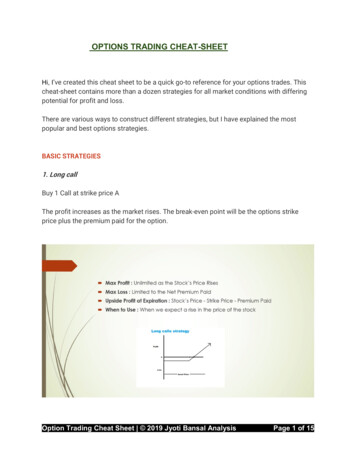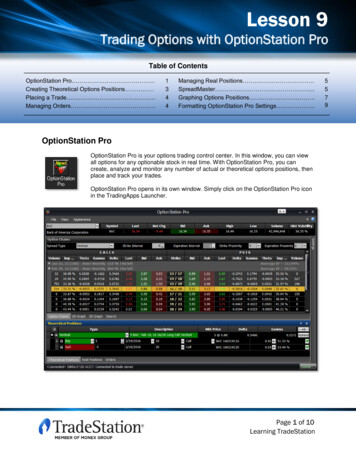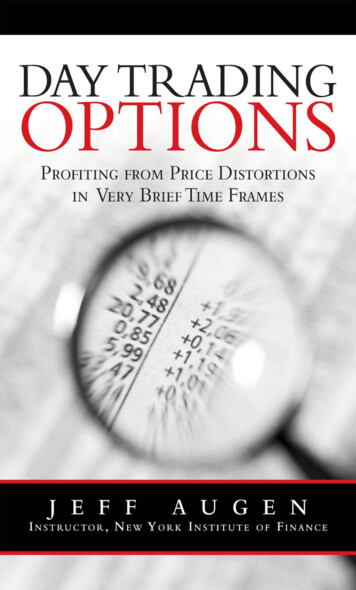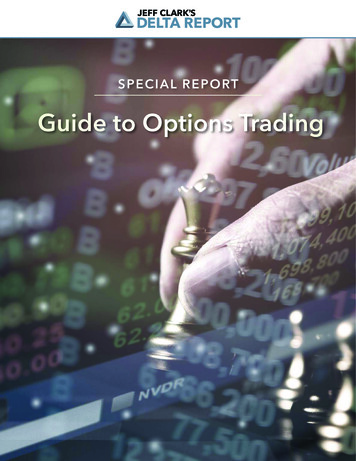
Transcription
SP E CIAL REPORTGuide to Options Trading
TABLE OF CONTENTS Introduction Three Major Factors that Determine the Price of Options An Easy Way to Understand Calls and Puts Determining Profit Potential How to Pick the Right Option Trade A Brief Options Glossary How to Calculate Risk and RewardIntroductionWhen you talk about options, most people thinkof risk. Dangerous leverage. Speculation.Gambling.are a few things you must keep in mind:Truth No. 1: Buying and selling options is aboutthe least risky and potentially most rewardinggame on Wall Street.I guess there is that aspect to it, if you don’t knowwhat you’re doing.Options master Victor Sperandeo racked up anominal rate of return of 70.7% without a losingyear between 1978 and 1989. With his astoundingtrack record, we’d be foolish not to pay attentionto what he has to say:See, most people don’t understand options. Thereason they were created in the first place is toreduce risk. In fact, the original options weredesigned to help investors hedge their portfoliosagainst bad moves in the market. Unfortunately,what’s happened over time is what happens toa lot of good ideas on Wall Street. options havemorphed into a commission-generating vehiclethey sell to folks as a way to get rich quick.“Options are, many say, the riskiest gamein town. Certainly they are by far the mostchallenging, flexible, and potentially profitablefinancial instruments available. But if you tradethem prudently, if you apply sound principles ofmoney management, trade only when the risk/reward ratio is highly in your favor, and executeyour trades with diligence and patience, then inall likelihood you will be profitable over the longterm. I can say, conservatively, that at least 40percent of all the returns I’ve made in my lifehave been with options.”If you think trading options will help you get richquick, I’ve got some bad news for you. While usingoptions can make you a lot of money, it’s not goingto happen overnight. Trading options is a process.And if you want to be in the options market for anylength of time. you have to do it the “right way.”Learning the “right way” to use options mightinvolve a little extra effort on your part if you wantto trade in the market successfully. But I can helpyou master the basics. I’ve traded options fornearly three decades. During that time, I’ve alsobeen teaching folks just like you how to reducetheir risk with options and add a little bit of “pop”to an otherwise conservative portfolio.Truth No. 2: Want to be a winner? Watch yourlosers!To succeed in trading options, you really need tolimit your trading to opportunities that have atleast a 3-to-1 payout. A 5-to-1 reward-to-risk ratio,of course, is better. But at minimum, you want tohave the potential to pocket 3 in return for everydollar you risk.This report contains everything you need to knowabout options, and nothing you don’t. First. here2
You accomplish many things by forcing aminimum 3-to-1 discipline on yourself. For one,it forces you to think in terms of reward andrisk, which is extremely important. Most failedoptions traders, even ones that may have hadgood trading systems, fail because they didn’t payenough attention to risk. If you’re willing to lose50% on a position, you’d better be expecting again of 150% or more – at least. That’s a tall order.to fold ‘em. But you’d sure hate to fold ‘em andtake a total loss with a big bet on the table. Sodon’t ever put yourself in that boat. Limit the sizeof your positions. You should only have 2%-3%of the money you’ve set aside for trading at riskon any one trade. We really can’t imagine anycombination of circumstances where you shouldconsider putting more than 10% of your tradingmoney on one play. Don’t do it!If you’re willing to lose it all (meaning have thepotential for a negative 100% return on a position),then you’d better be expecting a 300% to 500%plus gain in that position.To end up like Vic Sperandeo over the long run,you’ve got to stick to the program. Limit the sizeof your positions. (We’ll explain how to do thislater on in this report.) And limit your downside bynever allowing a small loss to turn into a big loss.Traders who follow this have a chance of beingwinners in options over the long run. Those whodon’t do this will be quickly drummed out of theclub, taken for every penny.When you see it in terms of risk versus reward, andyou realize that 500% winners don’t come alongevery day, you can see “risking it all” is a bad bet.Options are a lot like poker. Your hand is only asmall portion of the battle. Betting appropriatelyfor the entire game is really what’s important,which leads us to.Now, I’d like to turn your attention to the basics ofcall and put options. The next section comes frommy colleague and friend, Dr. Steve Sjuggerud.It’s one of the best explanations I’ve seen on thesubject Truth No. 3: Big winners make small betsYou’ve got to know when to hold ‘em and whenAn Easy Way to Understand Calls and PutsBy Dr. Steve SjuggerudThere’s a piece of land on the beach that I have myeye on. Empty lots on the water are hard to comeby around here – they rarely go on the market.And when they do, they’re snapped up pretty fast.around here, but I don’t want to tell him that. AndI need a little time to do my homework and get myfinances together.Here’s the deal I offer: “I’ll give you 10,000right now – that you can keep – if you can giveme a piece of paper giving me the right to buythis property for 1 million any time in the next30 days. If I decide not to buy it, you keep themoney.”I drive by it around dusk one day on my way to adinner party and see an old man on the property.I get out of my car and strike up a conversation,looking over the water. It turns out he’s the owner.I ask him if he’d ever consider selling the property.“Sure,” he says. “A million firm.”“You’ve got yourself a deal right there,” he says,happy to pocket the no-risk 10,000.Right on the spot, I try to work a deal. I think amillion is actually a good price for oceanfront3
I head out to the dinner party. At the party, I meetsome folks who’ve been looking to buy on theocean for months, but nothing has come on themarket. They mention that they’ll snap up the firstthing available, even over 1 million.market, basically just like the New York StockExchange. Only it’s the options exchange. And it’sin Chicago.The reality is, nobody goes through the hassleof exercising their right to buy, just like I didn’twhen it came to the land. I didn’t want the landtransferred to me before I sold it to the couple.And the same is true for stock options. Becausethere is an options exchange, people are tradingthese options all the time.Long story short, I sell them the old man’soceanfront lot for 1,050,000.I made a 400% profitin a few hours, by selling an asset that I controlled,but didn’t own.I could have completed the transaction two ways:Those are the basics of a call option. Now let mecover the basics of a put option.1) I could have exercised my right to buy the land,and gone through all the paperwork hassles anddocuments, taxes, and fees, only to turn aroundand go through all that again with the sale.USING YOUR HOMEOWNER’S POLICY TOUNDERSTAND PUTS2) I could have simply sold my “right to buy” pieceof paper to the couple for 50,000.Every time you buy an insurance policy, you areessentially buying a put option.For 10,000, I had the “option” to buy this landover the next 30 days. I could either buy the landor sell my right to buy. That’s exactly what anoption is.Take your homeowner’s policy as an example.When you sign on the dotted line and write yourcheck, you are essentially buying the right to sellyour house back to the insurance company fora certain value, under certain conditions, for alimited period of time. By accepting your money,the insurance company has taken on an obligationto buy your house back from you under the sameterms. The longer your policy has to run, the morethe insurance company will charge you. A sixmonth policy costs less than a 12-month policy. Itworks exactly the same way with put options. Thelonger it’s good for, the more it costs.Okay, I confess, this isn’t a true story. But it is aperfect example of buying a call option.A call option is the right (but not the obligation)to buy something at a particular price. That’spretty much it. I paid 10,000 to the old man forthe option to buy his property. I paid 10,000 for acall option.A call option has an expiration date. In this case,in 30 days, my call option would have expired– worthless. Options are worthless after theirexpiration date. You’d better either exercise theoption by buying the property or sell the optionto somebody else before it expires.As put-option buyers, we have two big advantagesover insurance-policy holders. First of all,most options are not subject to the terms andconditions of many insurance policies. A disasteris not necessary for them to “pay up.” In the caseof put options, the stock has to go down. That’s it.With stock options, you have the same choices asI did. You can either exercise the right to buy thestock at a certain price (like the 1 million figure),which is called the strike price. or you can sellthe option to somebody else through the optionsSecondly, unlike the insurance-policy holder,buyers and sellers of options are free to changetheir minds about a position for any reason. Youcan always exit or add to your position by simplybuying more or selling it in the market.4
For the most part, options are as easy to buyand sell as stocks. This makes them an idealinvestment for those who wish to take advantageof big moves, because it can be done without theexpense and risk of buying or selling huge chunksof stock.In short:Buyers of call options want the stock to go up.They only make money if the stock goes up.Buyers of put options want the stock to godown. They only make money if the stock falls.How to Pick the Right Option TradeI’ve found that one of the reasons many peopleshy away from the options market is that there arehundreds of options to choose from for any onestock. Remember. as Steve explained, an optionis a contract. It gives you the right to buy or sell astock at a specific price by some predetermineddate in the future. And picking the best one canbe confusing.chart from way back in 2012. Also, remember.option trading involves risk, and you can lose allthe money you put into a trade. While there areways you can limit your downside (as I’ll also showyou in this report), do not risk more than you canafford to lose.For example. A reader recently e-mailed me aquestion about buying call options on SLV (theiShares Silver Fund). “How do you know whichoption to trade?”TWO WAYS TO “TIME” YOUR TRADESNow, let’s figure out how to pick the rightexpiration month.When you buy an option, you’re buying time forthe stock to do something. The more time you buy,the more expensive the option. You want to besure to buy enough time for the stock to completethe move you’re anticipating. But you don’t wantto pay extra for the time you don’t need.You can buy SLV calls that expire a few weeksfrom now. You can go all the way out to January2018. Or you can pick from any number ofexpiration months in between.If you’re anticipating a stock will move higherbecause of some fundamental factor – likea positive earnings report or a favorableintroduction of a new product – you need to buyan option that expires after the event.You also have a number of strike prices to choosefrom. That’s the price at which you can either buy(in the case of call options) or sell (in the caseof put options) the underlying stock. The strikeprices in SLV range from a low of 10 per share toa high of 72.For example, if you think XYZ biotech stock isgoing to shoot higher after an FDA meeting in lateMay, you need to buy an option that expires inJune. An April contract does you no good.Picking the right option can be a tough decision.And it often makes the difference between a goodtrade and a bad one. So, I’m going to teach youhow to pick the right option.There’s no point buying July or August options inthis case, as you’d simply be paying for time youdon’t need.First, let’s get one disclaimer out of the way.What you’re about to read is an example ofhow I would select an option on SLV. It is foreducational purposes only and is not arecommendation. That's why we're using aHowever, if you’re buying an option based on atechnical chart pattern for a stock. things get alittle trickier.5
Some chart patterns resolve quickly. Risingand falling wedges, for example, usually leadto sudden moves in the stock once support orresistance is taken out. In these cases, you cantrade options with short expiration dates.this move should look to buy an option with a Mayexpiration date – just to be on the safe side.I recently put together a full options videocourse, covering everything from the basics(understanding options) to the advanced (how toproject where a stock is headed next). You canaccess all of these videos in the Delta ReportTraining Center.But in the case of SLV, we’re looking at a complexinverse “head and shoulders” pattern. This isa potentially bullish formation that could leadto huge gains. In this pattern, symmetry isimportant, and it’s going to take some time to playout. On the next page is SLV’s chart in April 2012.The bigger move, however, will come if the inverse“head and shoulders” pattern plays out and SLVbreaks above the neckline. The pattern projectsan 8 move higher, which is the distance fromthe head to the neckline. This move should takeanother two months to complete. Here’s how wefigure that out.There are two potential price targets on thischart. The first is the top dark red resistance line(neckline) at about 34.50 per share. The moresignificant target is the blue resistance line at 42.If this pattern develops into an inverse “head andshoulders” pattern, SLV should form the rightshou
limit your trading to opportunities that have at least a 3-to-1 payout. A 5-to-1 reward-to-risk ratio, of course, is better. But at minimum, you want to have the potential to pocket 3 in return for every dollar you risk. Introduction TABLE OF CONTENTS Introduction An Easy Way to Understand Calls and Puts How to Pick the Right Option Trade

